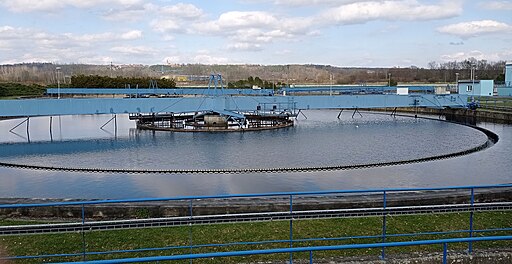Wastewater treatment focuses on cleaning and purifying polluted water, while water reclamation involves reusing treated wastewater for various non-potable purposes.
TL;DR Wastewater Treatment Vs. Water Reclamation
Wastewater treatment focuses on removing pollutants and contaminants from used water before it can be safely released back into the environment. This process involves several stages such as physical, chemical, and biological treatments to ensure that harmful substances are eliminated or reduced to acceptable levels.
Water reclamation goes a step further by treating wastewater to a level where it can be reused for various purposes. By utilizing advanced filtration techniques and disinfection processes, reclaimed water can be suitable for irrigation, industrial use, or even replenishing groundwater sources.
What is Wastewater Treatment

Wastewater treatment is a remarkable process that transforms dirty, contaminated water into something clean and safe for our environment. Wastewater refers to any used water that comes from our homes, businesses, or industries. This includes everything from toilet flushes and showers to dishwashing water and industrial runoff.
The aim of wastewater treatment is simple yet crucial: to remove harmful pollutants and contaminants so that the treated water can be safely returned to nature or reused in various applications. The process typically involves several stages: preliminary treatment, primary treatment, secondary treatment, and sometimes even tertiary treatment.
During preliminary treatment, large objects like sticks and debris are removed using screens or grates. Then comes the primary treatment phase where solid materials settle down as sludge while oils and grease float on top for removal. In secondary treatment, microorganisms break down organic matter in the remaining liquid through aeration or other biological processes.
Some wastewater treatments employ tertiary treatments for an extra level of purification before discharge or reuse. These advanced techniques may include filtration systems like activated carbon filters or disinfection methods such as ultraviolet (UV) light exposure.
Wastewater treatment plants play a vital role in safeguarding human health by preventing disease transmission through contaminated water sources. Additionally, they protect ecosystems by reducing pollution levels that could harm aquatic life and habitats.
What is Water Reclamation

Water reclamation is a process that involves treating wastewater to remove contaminants and make it suitable for reuse. Unlike traditional wastewater treatment, which focuses on removing pollutants and returning the water to the environment, water reclamation goes a step further by purifying the treated water for various non-potable uses.
The goal of water reclamation is to reduce reliance on freshwater sources by utilizing recycled water in industries such as agriculture, landscaping, and industrial processes. This helps conserve precious freshwater resources while also reducing the strain on existing infrastructure and ecosystems.
In the process of reclaiming water, advanced filtration methods are employed to remove any remaining impurities or pathogens. These methods can include membrane filtration, reverse osmosis, UV disinfection, and chemical treatments. The reclaimed water undergoes rigorous testing to ensure its quality meets specific standards before it can be safely used for its intended purpose.
Water reclamation offers numerous benefits beyond just conserving freshwater supplies. It reduces demand on potable water sources, mitigates drought effects by providing an alternative supply during dry periods, enhances overall sustainability efforts within communities, and reduces pollution from untreated wastewater discharge into rivers or oceans.
Wastewater Treatment Vs. Water Reclamation – Key Differences between
| Aspect | Wastewater Treatment | Water Reclamation |
|---|---|---|
| Objective | The primary goal is to remove pollutants and contaminants from wastewater to make it safe for discharge into natural bodies of water (rivers, lakes, oceans) or for returning to the environment. | The main aim is to treat and purify wastewater for reuse, typically for non-potable purposes like irrigation, industrial processes, or environmental restoration. |
| Treatment Level | The focus is on extensive treatment to meet environmental and public health standards, which often involves multiple stages and rigorous processes. | Treatment levels can vary, but the emphasis is on making the water suitable for specific, non-drinking water uses, which may require less extensive treatment. |
| Quality Standards | Wastewater treatment must meet strict water quality regulations and standards to protect the environment and public health. | Water reclamation standards are tailored to the intended reuse, so they may not be as stringent as those for drinking water. |
| End Use | The treated wastewater is typically discharged into natural water bodies or released back into the environment, where it may undergo further dilution and natural processes. | Reclaimed water is specifically treated for reuse in applications such as landscape irrigation, industrial processes, agricultural irrigation, or groundwater recharge. |
| Treatment Focus | Wastewater treatment plants focus on the removal of pathogens, organic matter, nutrients (nitrogen and phosphorus), heavy metals, and other contaminants. | Water reclamation may target certain contaminants but often prioritizes the removal of substances that can harm the intended reuse applications (e.g., salts, suspended solids, or specific chemicals). |
| Infrastructure Complexity | Wastewater treatment facilities tend to be more complex and extensive, requiring significant infrastructure and resources. | Water reclamation systems can be less complex and may involve decentralized treatment units depending on the scale and purpose of reuse. |
| Regulatory Oversight | Subject to strict environmental regulations and permits to ensure compliance with discharge standards. | Regulated by local and regional agencies, but standards can vary widely depending on location and intended reuse. |
| Public Health Concerns | Wastewater treatment prioritizes the removal of contaminants that pose a risk to public health and the environment. | Water reclamation is designed with specific non-potable uses in mind, minimizing risks associated with those uses. |
| Examples | Municipal sewage treatment plants, which clean sewage for safe discharge. | Reclaimed water systems in urban areas, industrial facilities, and agricultural operations that reuse treated wastewater for irrigation or cooling. |
Benefits of Wastewater Treatment and Water Reclamation
Benefits of Wastewater Treatment
- Environmental Protection: Wastewater treatment helps remove pollutants and contaminants from wastewater before it is discharged into natural bodies of water, reducing the adverse impact on aquatic ecosystems and wildlife.
- Public Health: By treating sewage and industrial effluents, wastewater treatment prevents the spread of waterborne diseases, protecting public health and sanitation.
- Water Conservation: It helps conserve freshwater resources by reducing the demand for new water sources, especially in water-scarce regions.
- Improved Water Quality: Treated wastewater poses fewer risks to human health and the environment, improving the overall quality of water bodies.
- Compliance with Regulations: Wastewater treatment facilities must adhere to strict environmental regulations, ensuring that discharged water meets established quality standards.
- Recharge of Groundwater: In some cases, treated wastewater can be used to replenish groundwater, helping to sustain underground aquifers.
- Resource Recovery: Some wastewater treatment processes allow for the recovery of valuable resources, such as energy, nutrients (nitrogen and phosphorus), and biosolids for use in agriculture.
Benefits of Water Reclamation
- Resource Efficiency: Water reclamation reduces the demand for freshwater sources by using treated wastewater for various non-potable purposes, conserving precious water resources.
- Sustainable Agriculture: Reclaimed water can be used for irrigation in agriculture, reducing the reliance on freshwater and minimizing the impact of agriculture on natural water sources.
- Industrial Applications: Industries can use reclaimed water in their processes, reducing their environmental footprint and costs associated with freshwater procurement.
- Landscape Irrigation: Reclaimed water is well-suited for watering lawns, parks, and golf courses, maintaining green spaces without using potable water.
- Reduced Discharge Loads: Water reclamation lowers the volume of wastewater discharged into the environment, decreasing the burden on wastewater treatment facilities and ecosystems.
- Drought Resilience: In regions prone to drought, water reclamation provides a reliable alternative water source, ensuring continued access to water for various purposes.
- Environmental Restoration: Reclaimed water can be used for environmental restoration projects, such as wetland rehabilitation, which helps restore ecosystems and wildlife habitats.
- Reduced Energy Costs: Transporting reclaimed water over shorter distances can result in energy savings compared to transporting potable water from distant sources.
- Mitigating Water Scarcity: In water-stressed areas, water reclamation can play a crucial role in addressing water scarcity challenges and promoting sustainable water management practices.
Image Credits
Featured Image By – Czeva, CC BY-SA 4.0 , via Wikimedia Commons
Image 1 By – Czeva, CC BY-SA 4.0 , via Wikimedia Commons
Image 2 By – Michael Barera, CC BY-SA 4.0 , via Wikimedia Commons








